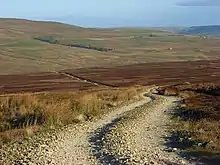Maiden Way
The Maiden Way or Maidenway (Middle English: Maydengathe; Medieval Latin: Via Puellarum) was a roughly 20-mile (32 km) Roman road in northern Britain connecting the Roman fort of Bravoniacum (Kirkby Thore) near Penrith with that of Magnae (Carvoran) on Hadrian's Wall, via the intermediate fort of Epiacum roughly half-way between the two. The Maiden Way was sometimes considered also to have run east along the Stanegate to Banna (Birdoswald), then 7 miles (11 km) north to the Shrine of Cocidius (Bewcastle), and thence to Liddesdale,[1][2] but the zig-zag identity of this course as a single road is problematic.[3]

In 2016, it was reported that investigations using LIDAR technology by the Environment agency for the purposes of flood mapping and other environmental management were providing extensive data showing the existence of underground archaeological features including Roman roads. This included a continuation of the Maiden Way southwards from Kirkby Thore to the Roman fort at Low Borrowbridge near Tebay.[4]
Bravoniacum was a waypoint on the northern leg of the Roman road connecting Luguvalium (Carlisle) with Eboracum (York) and points south. Magnae was one of the waypoints on the Stanegate beside Hadrian's Wall. As such, the Maiden Way served as a shortcut for supplying the central and eastern areas of the Wall. It also provided supplies to the lead and silver mines near Epiacum (Whitley Castle).[5]
Following the end of Roman rule in Britain, the Maiden Way was used as a drovers' road.[2] The route was probably named after the Maiden Castle[6] fortlet guarding the Stainmore Pass to the east of the fort of Verterae (Brough).[7]
The Pennine Way footpath follows the line of the Maiden Way for several miles on a roughly north-south route across Lambley Common in Northumberland, above the west bank of the river South Tyne. Immediately north of this stretch, a modern minor road follows the line of the Maiden Way for several miles to the west of Featherstone Castle.
See also
References
- "An Introduction to Roads and Travel in the Anglo-Scottish Borderlands of the Cheviot Region" (PDF). The Archaeological Practice. 2009. p. 17. Archived from the original (PDF) on 20 February 2015.
- Michie, Alexander (1863). "A Chapter on Old Local Bridges". Transactions of the Hawick Archaeological Society. Hawick: James Haining & Co.: 73.
- Haverfield, Francis John (1897), "Report of the Cumberland Excavation Committee, 1895", Transactions of the Cumberland and Westmorland Antiquarian and Archaeological Society, Kendal: T. Wilson, XIV (Part II): 428 ff
- "Lasers reveal 'lost' Roman roads". gov.uk. 3 February 2016. Retrieved 24 February 2018.
- Frodsham, Paul (2013). "Altogether Archaeology Fieldwork Module 3a: Maiden Way Roman Road Kirkby Thore Geophyics" (PDF). Northern Pennines AONB Partnership. Archived from the original (PDF) on 9 September 2013. Retrieved 20 February 2015..
- Norgate, Martin (2014). "Old Cumbria Gazetteer: Maiden Way". Portsmouth: Portsmouth University. Retrieved 20 February 2015.
- "Roxburghshire". The Topographical, Statistical, and Historical Gazetteer of Scotland. II. Edinburgh: A. Fullarton & Co. 1853. p. 624.
External links
- Codrington, Thomas (1903). "The Maiden Way". Roman Roads in Britain. Society for Promoting Christian Knowledge. pp. 181–183.
- "Altogether Archaeology, Theme 3. The Maiden Way Roman Road". Northern Pennines AONB Partnership. Archived from the original on 19 February 2015. Retrieved 19 February 2015..
- "Keys to the Past: Maiden Way Roman Road (Knaresdale with Kirkhaugh; Coanwood; Hartleyburn)". Durham & Northumberland County Councils..